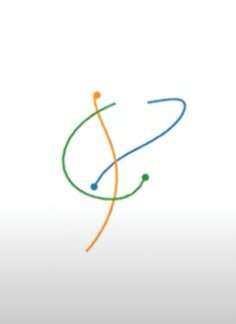
APRIL 13, 2021 by Hebrew University of Jerusalem
Collected at: https://phys.org/news/2021-04-theory-centuries-old-physics-problem.html?utm_source=nwletter&utm_medium=email&utm_campaign=weekly-nwletter
The ‘three-body problem,’ the term coined for predicting the motion of three gravitating bodies in space, is essential for understanding a variety of astrophysical processes as well as a large class of mechanical problems, and has occupied some of the world’s best physicists, astronomers and mathematicians for over three centuries. Their attempts have led to the discovery of several important fields of science; yet its solution remained a mystery.
At the end of the 17th century, Sir Isaac Newton succeeded in explaining the motion of the planets around the sun through a law of universal gravitation. He also sought to explain the motion of the moon. Since both the earth and the sun determine the motion of the moon, Newton became interested in the problem of predicting the motion of three bodies moving in space under the influence of their mutual gravitational attraction, a problem that later became known as ‘the three-body problem.’
However, unlike the two-body problem, Newton was unable to obtain a general mathematical solution for it. Indeed, the three-body problem proved easy to define, yet difficult to solve.
New research, led by Professor Barak Kol at Hebrew University of Jerusalem’s Racah Institute of Physics, adds a step to this scientific journey that began with Newton, touching on the limits of scientific prediction and the role of chaos in it.
The theoretical study presents a novel and exact reduction of the problem, enabled by a re-examination of the basic concepts that underlie previous theories. It allows for a precise prediction of the probability for each of the three bodies to escape the system.
Following Newton and two centuries of fruitful research in the field including by Euler, Lagrange and Jacobi, by the late 19th century the mathematician Poincare discovered that the problem exhibits extreme sensitivity to the bodies’ initial positions and velocities. This sensitivity, which later became known as chaos, has far-reaching implications—it indicates that there is no deterministic solution in closed-form to the three-body problem.
In the 20th century, the development of computers made it possible to re-examine the problem with the help of computerized simulations of the bodies’ motion. The simulations showed that under some general assumptions, a three-body system experiences periods of chaotic, or random, motion alternating with periods of regular motion, until finally the system disintegrates into a pair of bodies orbiting their common center of mass and a third one moving away, or escaping, from them.
The chaotic nature implies that not only is a closed-form solution impossible, but also computer simulations cannot provide specific and reliable long-term predictions. However, the availability of large sets of simulations led in 1976 to the idea of seeking a statistical prediction of the system, and in particular, predicting the escape probability of each of the three bodies. In this sense, the original goal, to find a deterministic solution, was found to be wrong, and it was recognized that the right goal is to find a statistical solution.
Determining the statistical solution has proven to be no easy task due to three features of this problem: the system presents chaotic motion that alternates with regular motion; it is unbounded and susceptible to disintegration. A year ago, Racah’s Dr. Nicholas Stone and his colleagues used a new method of calculation and, for the first time, achieved a closed mathematical expression for the statistical solution. However, this method, like all its predecessor statistical approaches, rests on certain assumptions. Inspired by these results, Kol initiated a re-examination of these assumptions.
The infinite unbounded range of the gravitational force suggests the appearance of infinite probabilities through the so-called infinite phase-space volume. To avoid this pathology, and for other reasons, all previous attempts postulated a somewhat arbitrary “strong interaction region”, and accounted only for configurations within it in the calculation of probabilities.
The new study, recently published in the scientific journal Celestial Mechanics and Dynamical Astronomy, focuses on the outgoing flux of phase-volume, rather than the phase-volume itself. Since the flux is finite even when the volume is infinite, this flux-based approach avoids the artificial problem of infinite probabilities, without ever introducing the artificial strong interaction region.
The flux-based theory predicts the escape probabilities of each body, under a certain assumption. The predictions are different from all previous frameworks, and Prof. Kol emphasizes that “tests by millions of computer simulations shows strong agreement between theory and simulation.” The simulations were carried out in collaboration with Viraj Manwadkar from the University of Chicago, Alessandro Trani from the Okinawa Institute in Japan, and Nathan Leigh from University of Concepcion in Chile. This agreement proves that understanding the system requires a paradigm shift and that the new conceptual basis describes the system well. It turns out, then, that even for the foundations of such an old problem, innovation is possible.
The implications of this study are wide-ranging and is expected to influence both the solution of a variety of astrophysical problems and the understanding of an entire class of problems in mechanics. In astrophysics, it may have application to the mechanism that creates pairs of compact bodies that are the source of gravitational waves, as well as to deepen the understanding of the dynamics within star clusters. In mechanics, the three-body problem is a prototype for a variety of chaotic problems, so progress in it is likely to reflect on additional problems in this important class.
More information: Barak Kol, Flux-based statistical prediction of three-body outcomes, Celestial Mechanics and Dynamical Astronomy (2021). DOI: 10.1007/s10569-021-10015-x
Provided by Hebrew University of Jerusalem
